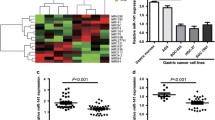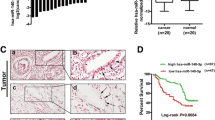Abstract
Increasing evidence indicates that microRNA (miR)-506 plays a vital role in tumorigenesis; however, the role of miR-506 in gastric cancer (GC) is unclear and needs further investigation. In the present study, we showed that the decrease in the expression of miR-506 is associated with tumor size, pathological tumor node metastasis (TNM) stage, and lymph node metastasis in 63 GC patient tumors. We found that patients with lower expression of miR-506 had a poor prognosis than that with the patients with high expression of miR-506. Notably, the ectopic expression of miR-506 was sufficient to inhibit cell proliferation, invasion, and epithelial-mesenchymal transition in the GC cells. Moreover, results from luciferase reporter assays identified miR-506 as a direct regulator of Yes-associated protein 1 (Yap1). Reintroduction of Yap1 rescues miR-506-induced effects on SGC-7901 cell proliferation and invasion. This function of miR-506/Yap1 axis is clinically significant, as the level of miR-506 is inversely correlated with Yap1 mRNA expression in matched tissues. Thus, our study demonstrates that miR-506 may act as a tumor suppressor in GC and that the miR-506/Yap1 axis may help us better understand the molecular mechanisms of GC progression.






Similar content being viewed by others
References
Siegel R, Ma J, Zou Z, Jemal A. Cancer statistics, 2014. CA: Cancer J Clin. 2014;64:9–29.
Tong F, Cao P, Yin Y, Xia S, Lai R, Liu S. Micrornas in gastric cancer: from benchtop to bedside. Dig Dis Sci. 2014;59:24–30.
Croce CM, Calin GA. MiRNAs, cancer, and stem cell division. Cell. 2005;122:6–7.
Han TS, Hur K, Xu G, Choi B, Okugawa Y, Toiyama Y, et al. MicroRNA-29c mediates initiation of gastric carcinogenesis by directly targeting ITGB1. Gut. 2015;64:203–14.
Xia J, Wu Z, Yu C, He W, Zheng H, He Y, et al. MiR-124 inhibits cell proliferation in gastric cancer through down-regulation of SPHK1. J Pathol. 2012;227:470–80.
Chen Q, Chen X, Zhang M, Fan Q, Luo S, Cao X. MiR-137 is frequently down-regulated in gastric cancer and is a negative regulator of CDC42. Dig Dis Sci. 2011;56:2009–16.
Bao W, Fu HJ, Xie QS, Wang L, Zhang R, Guo ZY, et al. HER2 interacts with CD44 to up-regulate CXCR4 via epigenetic silencing of microRNA-139 in gastric cancer cells. Gastroenterology. 2011;141:2076–87.
Yang SM, Huang C, Li XF, Yu MZ, He Y, Li J. MiR-21 confers cisplatin resistance in gastric cancer cells by regulating PTEN. Toxicology. 2013;306:162–8.
Li F, Liu B, Gao Y, Liu Y, Xu Y, Tong W, et al. Upregulation of microRNA-107 induces proliferation in human gastric cancer cells by targeting the transcription factor FOXO1. FEBS Lett. 2014;588:538–44.
Xia JT, Chen LZ, Jian WH, Wang KB, Yang YZ, He WL, et al. MicroRNA-362 induces cell proliferation and apoptosis resistance in gastric cancer by activation of NF-kappaB signaling. J Transl Med. 2014;12:33.
Li T, Lu YY, Zhao XD, Guo HQ, Liu CH, Li H, et al. MicroRNA-296-5p increases proliferation in gastric cancer through repression of caudal-related homeobox 1. Oncogene. 2014;33:783–93.
Yang D, Sun Y, Hu L, Zheng H, Ji P, Pecot CV, et al. Integrated analyses identify a master microRNA regulatory network for the mesenchymal subtype in serous ovarian cancer. Cancer Cell. 2013;23:186–99.
Liu G, Sun Y, Ji P, Li X, Cogdell D, Yang D, et al. MiR-506 suppresses proliferation and induces senescence by directly targeting the CDK4/6-FOXM1 axis in ovarian cancer. J Pathol. 2014;233:308–18.
Wen SY, Lin Y, Yu YQ, Cao SJ, Zhang R, Yang XM, et al. MiR-506 acts as a tumor suppressor by directly targeting the hedgehog pathway transcription factor GLI3 in human cervical cancer. Oncogene. 2015;34:717–25.
Kapoor A, Yao W, Ying H, Hua S, Liewen A, Wang Q, et al. Yap1 activation enables bypass of oncogenic Kras addiction in pancreatic cancer. Cell. 2014;158:185–97.
Jiao S, Wang H, Shi Z, Dong A, Zhang W, Song X, et al. A peptide mimicking VGLL4 function acts as a YAP antagonist therapy against gastric cancer. Cancer Cell. 2014;25:166–80.
Song M, Cheong JH, Kim H, Noh SH, Kim H. Nuclear expression of Yes-associated protein 1 correlates with poor prognosis in intestinal type gastric cancer. Anticancer Res. 2012;32:3827–34.
Johnson R, Halder G. The two faces of hippo: targeting the hippo pathway for regenerative medicine and cancer treatment. Nat Rev Drug Discov. 2014;13:63–79.
Ma Y, Yang Y, Wang F, Wei Q, Qin H: Hippo-YAP signaling pathway: a new paradigm for cancer therapy. Int J Cancer J Int Du Cancer. 2014.
Zeng Q, Hong W. The emerging role of the hippo pathway in cell contact inhibition, organ size control, and cancer development in mammals. Cancer Cell. 2008;13:188–92.
Streicher KL, Zhu W, Lehmann KP, Georgantas RW, Morehouse CA, Brohawn P, et al. A novel oncogenic role for the miRNA-506-514 cluster in initiating melanocyte transformation and promoting melanoma growth. Oncogene. 2012;31:1558–70.
Tong JL, Zhang CP, Nie F, Xu XT, Zhu MM, Xiao SD, et al. MicroRNA 506 regulates expression of PPAR alpha in hydroxycamptothecin-resistant human colon cancer cells. FEBS Lett. 2011;585:3560–8.
Wang Y, Cui M, Sun BD, Liu FB, Zhang XD, Ye LH. Mir-506 suppresses proliferation of hepatoma cells through targeting yap mRNA 3′ UTR. Acta Pharmacol Sin. 2014;35:1207–14.
Lim B, Park JL, Kim HJ, Park YK, Kim JH, Sohn HA, et al. Integrative genomics analysis reveals the multilevel dysregulation and oncogenic characteristics of TEAD4 in gastric cancer. Carcinogenesis. 2014;35:1020–7.
Jiang CG, Lv L, Liu FR, Wang ZN, Liu FN, Li YS, et al. Downregulation of connective tissue growth factor inhibits the growth and invasion of gastric cancer cells and attenuates peritoneal dissemination. Mol Cancer. 2011;10:122.
Maeta N, Osaki M, Shomori K, Inaba A, Kidani K, Ikeguchi M, et al. CYR61 downregulation correlates with tumor progression by promoting MMP-7 expression in human gastric carcinoma. Oncology. 2007;73:118–26.
Harvey KF, Zhang X, Thomas DM. The hippo pathway and human cancer. Nat Rev Cancer. 2013;13:246–57.
Zhou GX, Li XY, Zhang Q, Zhao K, Zhang CP, Xue CH, et al. Effects of the hippo signaling pathway in human gastric cancer. Asian Pacif J Cancer Prev: APJCP. 2013;14:5199–205.
Tsai BP, Hoverter NP, Waterman ML. Blending hippo and WNT: sharing messengers and regulation. Cell. 2012;151:1401–3.
Tschaharganeh DF, Chen X, Latzko P, Malz M, Gaida MM, Felix K, et al. Yes-associated protein up-regulates jagged-1 and activates the notch pathway in human hepatocellular carcinoma. Gastroenterology. 2013;144:1530–42.
Tumaneng K, Schlegelmilch K, Russell RC, Yimlamai D, Basnet H, Mahadevan N, et al. YAP mediates crosstalk between the Hippo and PI(3)K-TOR pathways by suppressing PTEN via miR-29. Nat Cell Biol. 2012;14:1322–9.
Acknowledgments
This work was supported by the JiangXi Province Talent 555 Project and the National Natural Science Foundation of China (No. 81160281 and 81441083).
Conflicts of interest
None
Author information
Authors and Affiliations
Corresponding author
Additional information
Jun Deng is the first author.
Rights and permissions
About this article
Cite this article
Deng, J., Lei, W., Xiang, X. et al. MicroRNA-506 inhibits gastric cancer proliferation and invasion by directly targeting Yap1. Tumor Biol. 36, 6823–6831 (2015). https://doi.org/10.1007/s13277-015-3364-8
Received:
Accepted:
Published:
Issue Date:
DOI: https://doi.org/10.1007/s13277-015-3364-8




